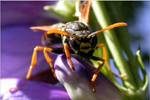After a long observation, researchers have found that the ants speak like us! Let’s read this article…..
The researcher, Dr. Robert Hickling, has spent long years in insect observation and monitoring audio frequencies made by it. But, there was no possibility to confirm that only when he was able to record the voices issued by ants! The aim was to track the presence of ants in agricultural crops and scientists found that the most effective way is by tracking the voice of ants!
But what amazed this scientist is that the sound frequencies issued by ants vary from an ant to another, from one gender to another and from one situation to another! There are 12 thousand kinds of ants in the world, and the number of ants on the ground is more than doubles the number of people, this multiplicity puzzled researchers how to deal with these voices.
He has been able to record different voices of ants. Those researches have been published on the magazine Journal of Sound and Vibration in 2006, and it was the first time that man heard a real voice of ants!

This researcher has published many researches; the most important one is on ants’ communication, entitled Analysis of acoustic communication by ants on the magazine The Journal of the Acoustical Society of America. The result of this research shows that ants outperform us in the sense of hearing. Scientists expect that the ant uses feelers for the broadcasting and reception of audio-frequencies. the ant aggrandize the received acoustic signals like modern receivers, and even remove different influences in the process of filtering or purification of voice to distinguish it! This is a very sophisticated system of communication which was unknown to scientists, and not only discovered but a few years ago, but glorious Quran has talked about this and told us that ants speak, the Almighty says:
(till, when they came to the valley of the ants, one of the ants said:’’O ants enter your dwellings, lest Sulaiman (Solomon) and his hosts should crush you, while they perceive not’’). [AN-Naml (ants): 18].

In this verse there is a clear reference to a language of understanding between ants, and God gave the prophet Solomon the ability to hear these voices and understand it. Today scientists are trying to understand these acoustic signals made by ants, and after long years of observation they distinguish four types of these voices.
Ants use audio signals especially pronounced during the sense of danger, we find that one of ants undertake the task of warning, she launches an appeal which the other ants receive, understand and immediately respond to it. Here I invite you to listen to the voice of this ant when she is warning the rest of the ants from a danger. Click here
——————-
By: Abduldaem Al-Kaheel
Sources:
- Hickling R, Brown RL. Analysis of acoustic communication by ants, The Journal of the Acoustical Society of America, Oct. 2000. http://www.ncbi.nlm.nih.gov/pubmed/11051518
- http://scitation.aip.org/getpdf/servlet/GetPDFServlet?filetype=pdf&id=JASMAN000108000004001920000001&idtype=cvips&prog=normal
- http://home.olemiss.edu/~hickling/
- Hickling, R. 1999. Ants have an acoustic world of their own. Meeting of the Entomological Society of America. Dec. 12-16. Atlanta.
- Roces, F., and B. Hِlldobler. 1996. Use of stridulation in foraging leaf-cutting ants: Mechanical support during cutting or short-range recruitment signal? Behavioral Ecology and Sociobiology 39:293.
- . Vibrational communication between hitchhikers and foragers in leaf-cutting ants (Atta cephalotes). Behavioral Ecology and Sociobiology 1995.
- Cocroft, R. 1999. Thornbug to thornbug: The inside story of insect song. Natural History (October). Available at http://www.amnh.org/naturalhistory/features/october99_thornbugs.html.
- DeVries, P.J. 1992. Singing caterpillars, ants and symbiosis. Scientific American 267(October):76-82. See http://www.science-frontiers.com/sf085/sf085b06.htm.
- Hِlldobler, B., and E.O. Wilson. 1990. The Ants. Cambridge, Mass.:Harvard University Press.
- Milius, S. 1998. Old MacDonald was an ant. Science News 154(Nov. 21):334.
- Raloff, J. 1994. When this fly arrives, ants’ heads will roll. Science News 146(Nov. 26):358.



